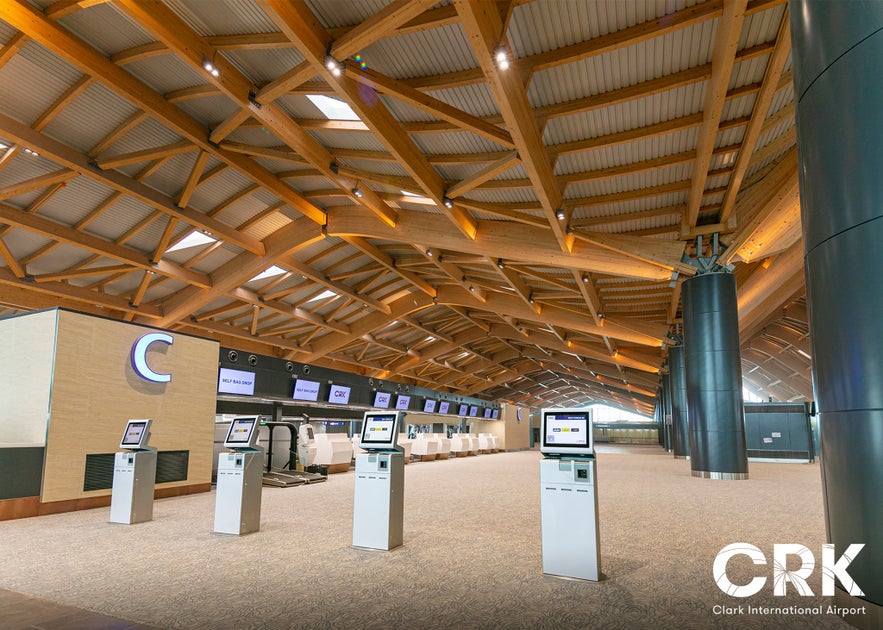
Photo by Clark International Airport
Because the Philippines is an archipelago, flying is the most convenient and fastest way to explore its major regions. Most visitors who would like to experience the Philippines' best beaches, islands, mountains, and other spectacular attractions have to go through at least a few airport transfers, thanks to the geographical features of the Philippines.
For your epic vacation in the Philippines, you need to plan your flights to the Philippines and entry and transfer points carefully. Learning more about the major airports in the Philippines will help you determine the most suitable airport to land in.
- Read our guide on transportation in the Philippines
- Check our article on the best cars to rent in the Philippines
Like many countries, the busiest Philippine airports are those located in the most prominent cities. The Ninoy International Airport (NAIA) or Manila Airport lies in the National Capital Region (NCR) or Metro Manila and is the country’s main flight hub.
Mactan-Cebu International Airport or Cebu Airport in the province of Cebu is the second most prominent airport in the Philippines and is the primary flight center in the Visayas Region. It is located on Mactan Island and is linked to the Cebu Metropolitan Area via the San Juanico Bridge.
The Iloilo Airport is another international airport located in the Visayas. This airport serves the regional center of Iloilo City and the rest of the Iloilo province.
Davao International Airport or Davao Airport in the city of Davao stands out within the Philippines' Mindanao region for its sheer size and passenger traffic flow.
Clark Airport serves the Northern Luzon area and is one of the major airports in the Philippines. It is only approximately 108 kilometers from NAIA. Thus, passenger transfers between these two airports are common.
Airports in Luzon Philippines
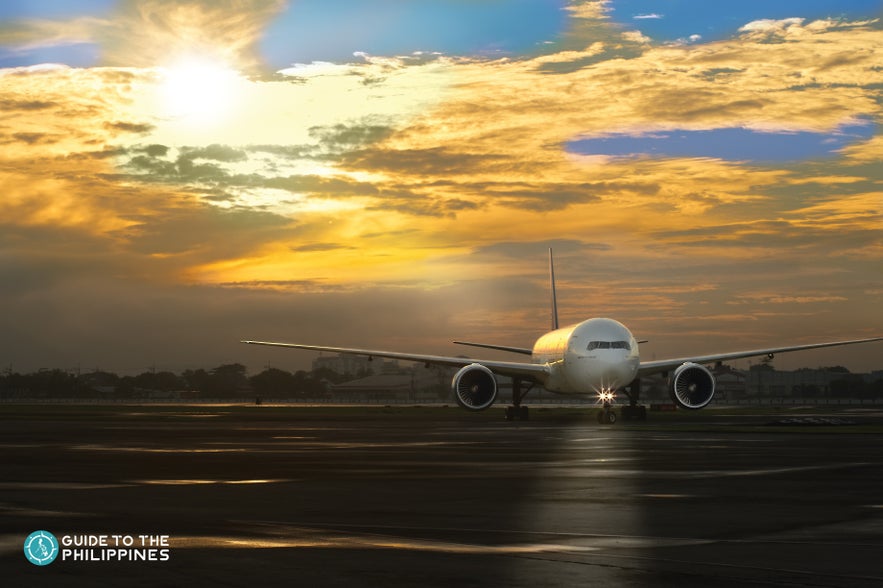
Luzon is the northernmost geographical region in the Philippines. It is home to several Luzon tourist spots and two major airports in the country, NAIA and Clark Airport.
Ninoy Aquino International Airport (Manila Airport/Manila International Airport)
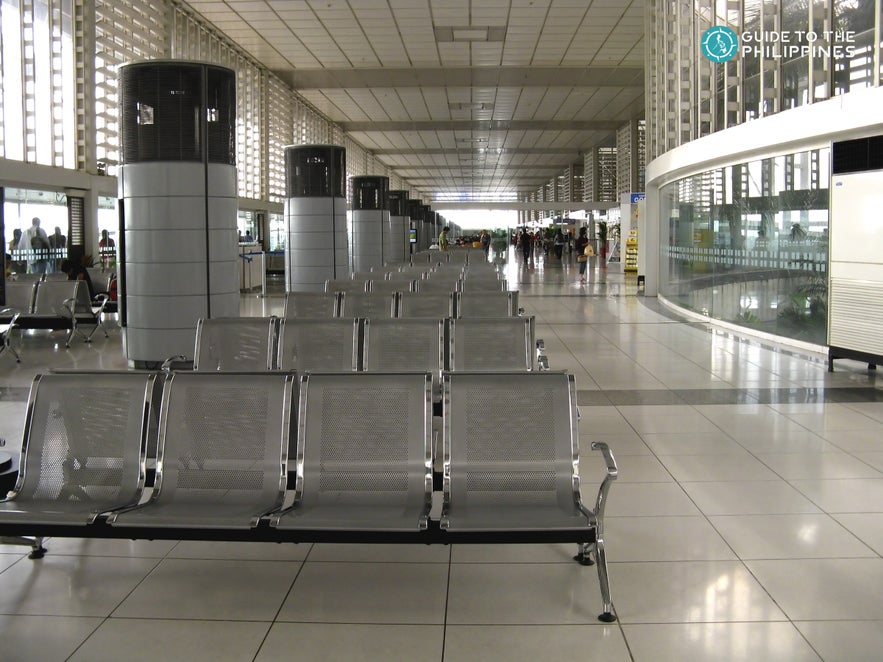
Manila Airport Codes - IATA Code: MNL, ICAO: RPLL.
When you arrive in Luzon from an international location, you will most likely land at NAIA (pronounced as na-ee-ya). Often called Manila Airport, NAIA is located in the southern section of Metro Manila. This airport receives the most number of international passengers and services all the major international airlines.
Aside from accommodating international flights, NAIA is the main hub for domestic flights across the country.
Airlines at Manila Airport
NAIA services several airlines that go to and from international destinations:
-
Air China - Beijing
-
Air Nuigini - Port Moresby
-
AirAsia - Kuala Lumpur
-
All Nippon Airways - Tokyo-Haneda, Tokyo-Narita
-
Asiana Airlines - Seoul-Incheon
-
Cathay Pacific - Hong Kong
-
Cebu Pacific - Bandar Seri Begawan, Bangkok–Suvarnabhumi, Beijing–Capital, Denpasar/Bali, Dubai–International, Fukuoka, Guangzhou, Hanoi, Ho Chi Minh City, Hong Kong, Jakarta–Soekarno-Hatta, Kota Kinabalu, Kuala Lumpur–International, Macau, Melbourne, Nagoya–Centrair, Osaka–Kansai, Seoul–Incheon, Shanghai–Pudong, Shenzhen, Singapore, Sydney, Taipei–Taoyuan, Tokyo–Narita, Xiamen
-
China Airlines - Kaohsiung, Taipei-Taoyuan
-
China Eastern Airlines - Shanghai-Pudong
-
China Southern Airlines - Guangzhou, Shenzhen
-
Emirates - Dubai
-
Ethiopian Airlines - Addis Ababa, Bangkok-Suvarnabhumi
-
Etihad Airways - Abu Dhabi
-
EVA Air - Taipei-Taoyuan
-
Gulf Air - Bahrain
-
Hong Kong Airlines - Hong Kong
-
Japan Airlines - Osaka-Kansai, Tokyo-Narita
-
Jeju Air - Seoul-Incheon
-
Jetstar Asia Airways - Osaka-Kansai, Singapore
-
Jetstar Japan - Nagoya-Centrair, Osaka-Kansai, Tokyo-Narita
-
KLM - Amsterdam
-
Korean Air - Seoul-Incheon
-
Kuwait Airways - Kuwait City
-
Lanmei Airlines - Phnom Penh
-
Malaysia Airlines - Kuala Lumpur
-
Oman Air - Muscat
-
Philippine Airlines - Auckland, Bangkok–Suvarnabhumi, Beijing–Capital, Brisbane, Busan, Dammam, Denpasar/Bali, Doha, Dubai, Fukuoka, Guam, Guangzhou, Hanoi, Ho Chi Minh City, Hong Kong, Honolulu, Jakarta–Soekarno-Hatta, Kuala Lumpur, London–Heathrow, Los Angeles, Macau, Melbourne, Nagoya–Centrair, New York–JFK, Osaka–Kansai, Phnom Penh, Port Moresby, Quanzhou, Riyadh, San Francisco, Sapporo–Chitose, Seoul–Incheon, Shanghai–Pudong, Singapore, Sydney, Taipei–Taoyuan, Tel Aviv, Tokyo–Haneda, Tokyo–Narita, Toronto–Pearson, Vancouver, Xiamen
-
AirAsia Philippines - Bangkok–Don Mueang, Denpasar/Bali, Ho Chi Minh City, Hong Kong, Kaohsiung, Kota Kinabalu, Kuala Lumpur–International, Macau, Osaka–Kansai, Seoul–Incheon, Shanghai–Pudong, Shenzhen
-
Qantas - Sydney
-
Qatar Airways - Doha
-
Royal Air Philippines - charter flights to Nanning, Sihanoukville
-
Royal Brunei - Bandar Seri Begawan
-
Saudi - Jeddah, Riyadh
-
Scoot - Singapore
-
Singapore Airlines - Singapore
-
Stalux Airlines - Taipei-Taoyuan
-
Thai Airways - Bangkok-Suvarnabhumi
-
Turkish Airlines - Istanbul
-
United Airlines - Guam, Koror
-
XiamenAir- Quanzhou, Xiamen
Manila Airport Terminals
There are four NAIA terminals with different entry points that are not within walking distance of each other. Each terminal serves specific airlines and routes. Here is an overview of the airport terminals:
Manila Airport NAIA Terminal 1

This is the oldest international terminal at NAIA. The majority of international flights land at this terminal, which receives about six million passengers every year.
- Find international flights to Manila:
- Book Philippine car rentals:
Manila Airport NAIA Terminal 2
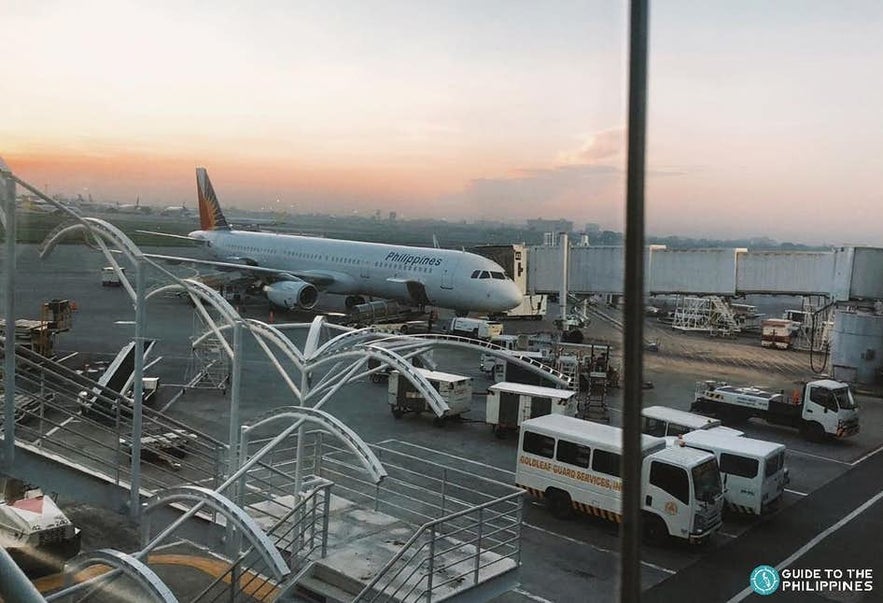
This terminal is also called the Centennial Terminal because it was built to commemorate the Philippines’ 100 years of independence. The national flag carrier, Philippine Airlines, used to operate at Terminal 2 exclusively. However, beginning July 2023, Terminal 2 became a purely domestic terminal and Philippine Airlines now shares it with other airlines with domestic routes, including AirAsia.
Manila Airport NAIA Terminal 3
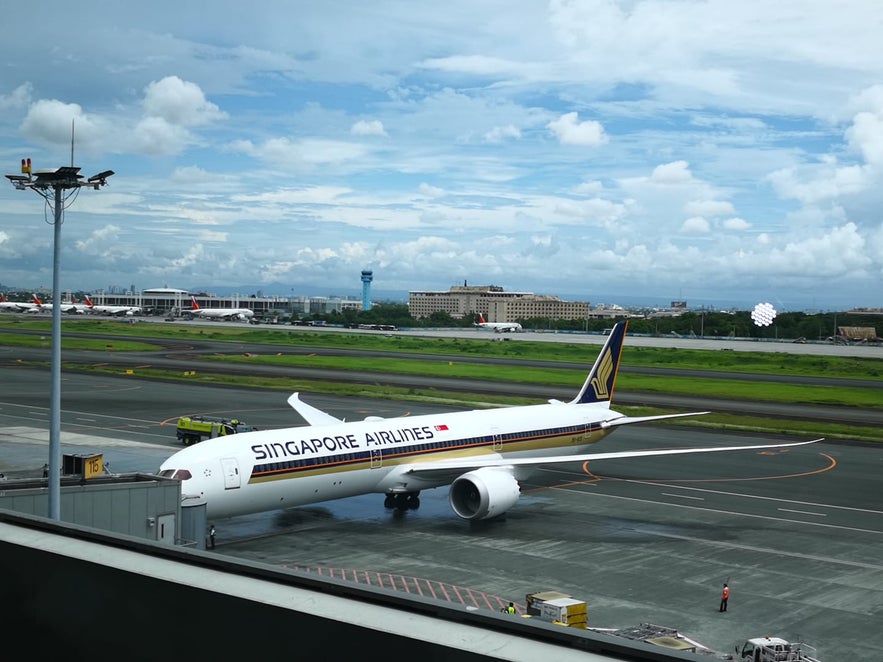
Photo by Manila International Airport Authority
Terminal 3 is the newest and biggest of the NAIA terminals. International Cebu Pacific flights are serviced at this terminal. AirAsia flights, All Nippon Airways, Cathay Pacific, Delta Air Lines, Emirates, KLM, Qantas, Qatar Airways, Singapore Airlines, Turkish Airlines, and United Airlines are the international airlines based in Terminal 3.
Manila Airport NAIA Terminal 4
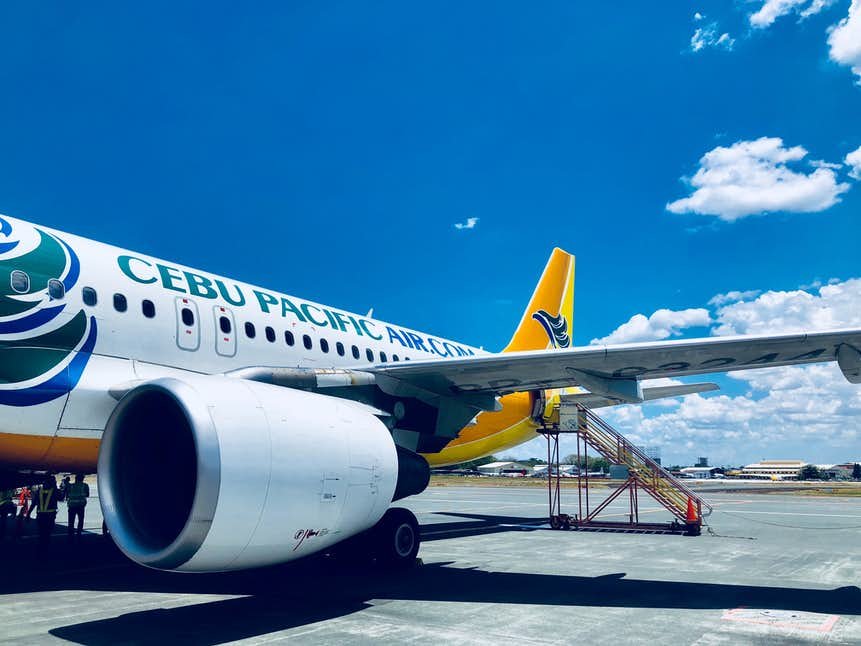
Photo by Xavier Summer
Also known as the Old Domestic Terminal, Terminal 4 caters to domestic flights facilitated by airlines like AirAsia Philippines, AirSWIFT, Cebgo, SkyJet, and Sky Pasada.
- Find domestic flights to Manila
- Book Manila airport transfers and other airport pick-up and drop-off services
Destinations accessible from Manila Airport
Manila Airport will give you easy access to the business and commercial districts of Makati and Taguig. You can also head to the capital Manila, which is home to historical spots like Rizal Park, Intramuros (Walled City), and Binondo. You can explore these destinations by booking Intramuros tours.
- Book Manila day tours and Manila vacation packages
- See other Manila tourist spots
- Browse hotels near Manila Airport
Batangas, which is home to natural wonders like Taal Volcano, Anilao, and Mt. Maculot, is 85 to 100 km from Manila Airport. From NAIA, you can also head straight to the popular surfing province of La Union (278 km) and Laguna (93 km), a favorite local holiday destination.
Manila Airport Connecting Flights
From NAIA, you can get on a connecting domestic flight to popular Philippines tourist spots. Some of these spots include the Chocolate Hills in Bohol, the windy islands of Batanes, and the pristine Coron archipelago of Palawan. Caticlan, the gateway to the world-famous holiday island of Boracay, is only a 45-minute flight from Manila Airport.
Clark International Airport
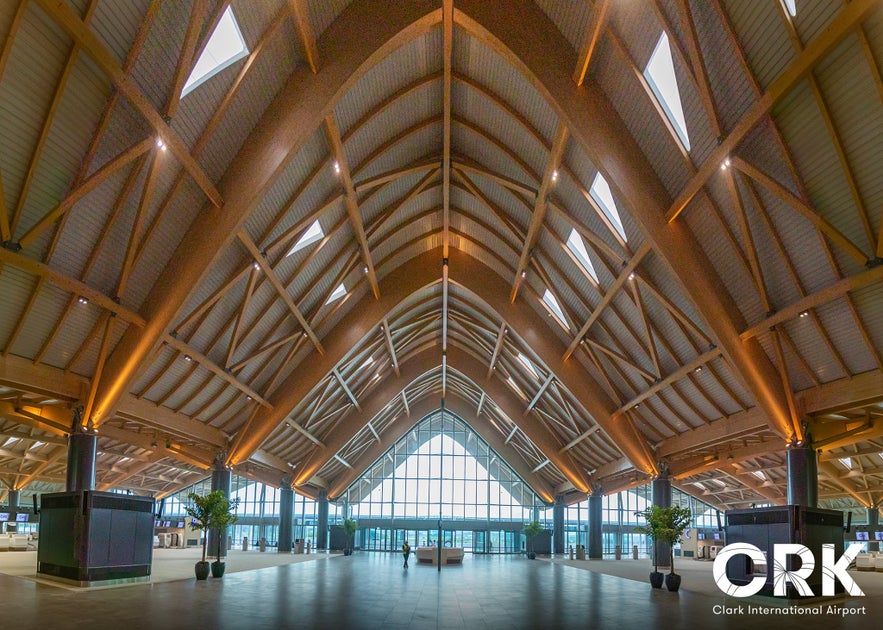
Photo by Clark International Airport
Clark Airport Codes - IATA: CRK, ICAO: RPLC
Formerly known as Diosdado Macapagal International Airport, Clark International Airport is the second most prominent airport on Luzon Island. This airport serves the Angeles and Mabalacat Cities, which both belong to the Clark Freeport Zone in Pampanga. It was named after Clark Air Base, a former American military base in the region. Clark Airport is situated along Andres Bonifacio Avenue in Clark Freeport Zone, Mabalacat, Pampanga.
Airlines at Clark International Airport
Clark Airport facilitates several international flights every day. Here are the airlines you can find here:
-
Asiana Airlines - Seoul-Incheon
-
Emirates - Dubai
-
Jeju Air - Seoul- Incheon
-
Jetstar Asia Airways - Osaka/Kansai and Singapore
-
Jin Air - Seoul-Incheon
-
Korean Air - Seoul-Incheon
-
Qatar Airways - Doha
-
Scoot - Singapore
Clark Airport Terminal/s
At the moment, Clark International Airport has one single passenger terminal building, which houses both the domestic and international flight areas. This building has undergone a few expansions and reconstructions. It currently has two floors with arrival and departure lounges. Clark Airport can accommodate about 4 million passengers per year.
Destinations Accessible from Clark Airport
Clark Airport is accessible through the Subic-Clark-Tarlac Expressway. From Clark Airport, you can reach key provinces within Central and Northern Luzon, like Tarlac and Pampanga.
Some attractions close to Clark Airport include the Puning Hot Spring and Volcanic Spa (12 km). Mount Pinatubo is an easy day trip from Clark, while Mount Arayat National Park is 28 km away. Metro Manila is about 96.5 km from this airport.
From Clark Airport, you can also fly domestically to key cities like Cebu and Davao. Philippine Airlines, Air Asia, and Cebu Pacific are the airlines that offer the mentioned routes. Sunlight Air also operates domestic flights from Clark to Busuanga, the gateway to the beautiful islands of Coron.
Airports in Visayas Philippines
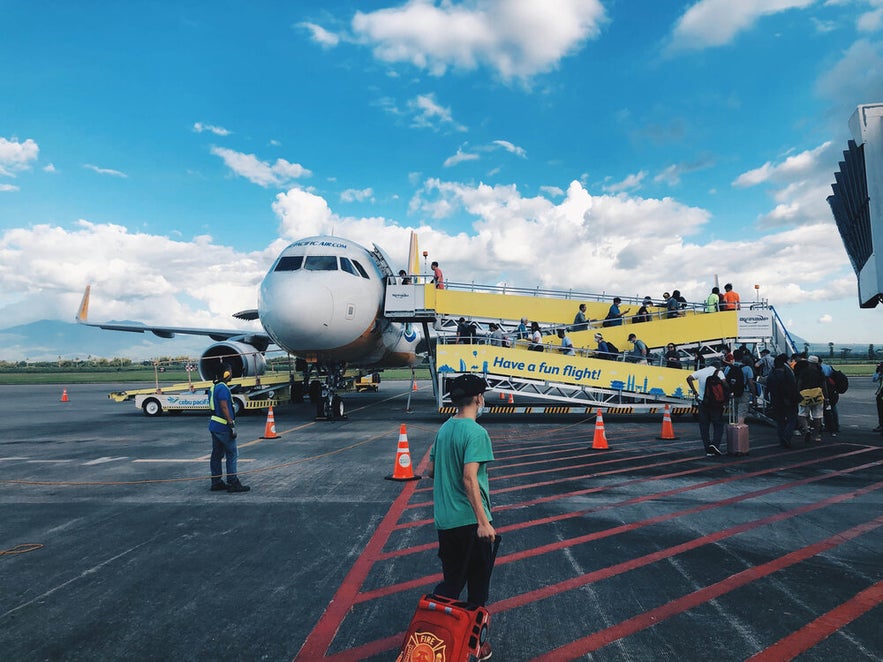
Photo by Iloilo Provincial Tourism
Located in the central part of the Philippines, the Visayas is one of the main geographical regions in the country. The Visayas is made up of several islands and is surrounded by the Visayan Sea. Visayas tourist spots are peppered throughout different islands. There is an airport on all prominent islands in the Visayas to make traveling between places easier. These islands are Cebu, Bohol, Negros, Panay, Leyte, Samar, and Palawan.
The Mactan-Cebu International Airport and the Iloilo International Airport are considered to be some of the best airports in the Philippines.
Mactan Cebu International Airport (Cebu Airport)
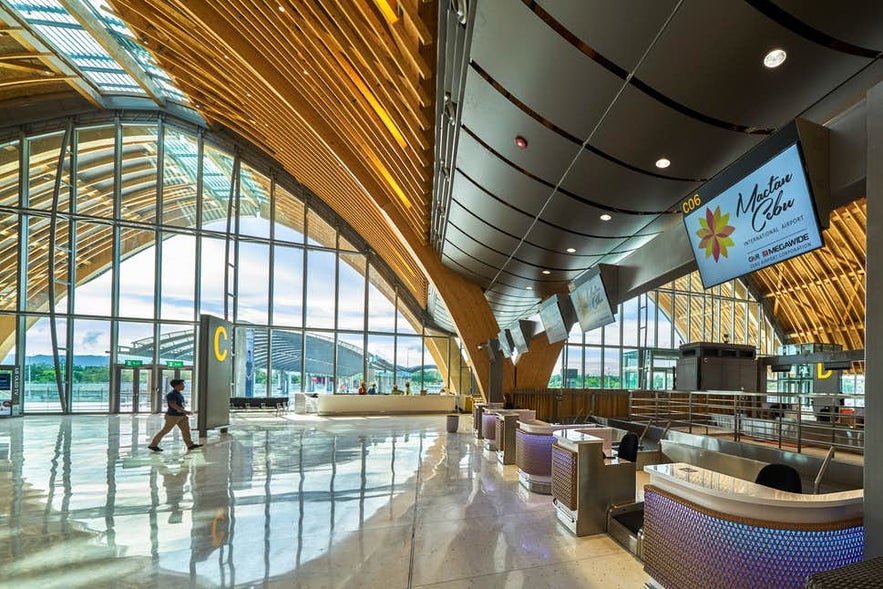
Photo by Mactan-Cebu International Airport / Steve Lee
Cebu Airport Codes - IATA: CEB and ICAO: RPVM
Mactan Cebu International Airport, sometimes called Cebu Airport, is the most well-known airport in the Visayas region. It is also the second primary flight hub in the country.
- Book flights to Cebu
- Find Cebu airport transfers
- Secure your Cebu hotel booking
Covering an area of about 797 hectares, Cebu Airport sits on Mactan Island, particularly within the Lapu-Lapu City territory. It can accommodate about 4.5 million passengers every year.
Airlines in Cebu Airport
This airport serves 36 domestic destinations and 37 international routes. Cebu Airport international flights and airlines include:
-
Air Busan - Busan, Seoul–Incheon
-
Asiana Airlines - Seoul–Incheon
-
Cathay Pacific - Hong Kong
-
China Eastern Airlines - Shanghai–Pudong, Nanjing (seasonal)
-
China Southern Airlines - Guangzhou
-
Emirates - Dubai
-
EVA Air - Taipei–Taoyuan
-
Jeju Air - Busan, Daegu, Muan, Seoul–Incheon
-
Jin Air - Busan, Seoul–Incheon
-
Juneyao Airlines -Shanghai–Pudong (Seasonal)
-
Korean Air - Seoul–Incheon
-
Lucky Air - Kunming
-
Pan Pacific Airlines - Seoul–Incheon
-
Air Asia Philippines - Kuala Lumpur–International, Seoul–Incheon, Shenzhen, Singapore, Taipei–Taoyuan
-
Qatar Airways - Doha
-
Scoot - Singapore
-
Sichuan Airlines - Chongqing
-
Tigerair Taiwan - Taipei–Taoyuan
-
T'way Air - Daegu
-
XiamenAir - Chengdu–Shuangliu, Quanzhou, Xiamen
Cebu Airport Terminals
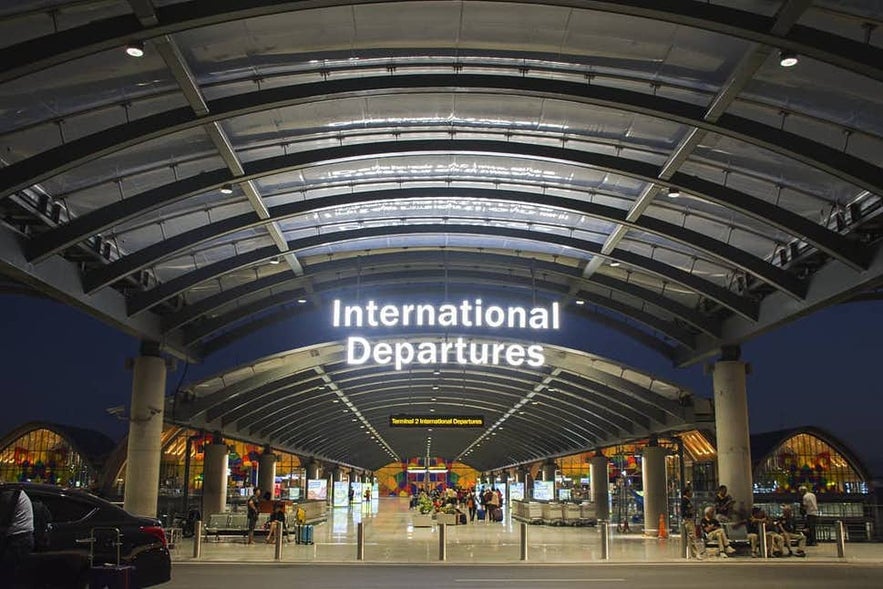
Photo by Mactan-Cebu International Airport
There are two terminals within the Mactan-Cebu International Airport. Terminal 1 accommodates domestic flights, while Terminal 2 serves as the international flight section. Terminal 2 is renowned for its eye-catching design. It won an award at the World Architecture Festival in 2019.
Destinations Accessible from Cebu Airport

Photo by Mactan-Cebu International Airport
From Cebu Airport, you can easily reach Cebu City, which is 15 KM away. Cebu City is home to important Philippine historic landmarks like Magellan’s Cross and Basilica Minore del Santo Niño de Cebu. Other Cebu tourist spots accessible from Cebu Airport by land include Osmeña Peak (114 km) and Kawasan Falls (132 km). The beaches in Cebu that can be found in Moalboal (99 km) and Oslob (132 km) are also accessible via land from Cebu Airport. You can also visit Malapascua beaches and Bantayan Island beaches.
- Book Cebu tours and Cebu tour packages
The Cebu International Airport facilitates domestic flights to key places in Central Visayas. From here, you can take a short flight to Bohol, home to the famous Chocolate Hills; and Kalibo, gateway to Boracay. You can also fly to prominent cities like Davao, Zamboanga, and General Santos.
Iloilo International Airport (Iloilo Airport)
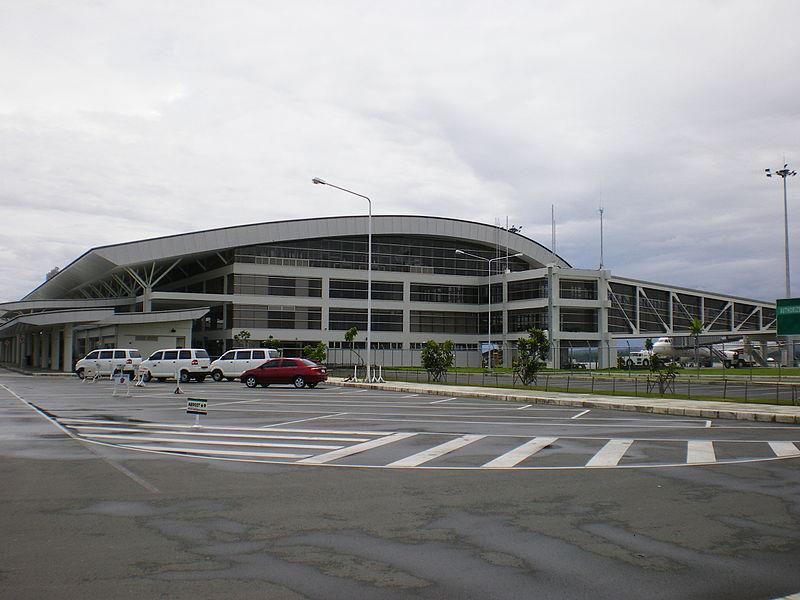
Photo by Iloilo International Airport
Airport Codes - IATA: ILO, ICAO: RPVI
Opened in 2007, this airport is also referred to as the Cabatuan Airport. It is one of the biggest, busiest, and most modern airports in the country.
The Iloilo International Airport is about 19 km northwest of Iloilo City. It is specifically located along Iloilo Airport Access Road, Cabatuan.
Airlines at Iloilo Airport
Iloilo Airport facilitates four major airlines: Cebu Pacific, Philippines Airlines, Air Asia Philippines, and CebGo. These airlines fly domestic routes from the airport.
Iloilo International Airport services flights to key domestic destinations:
-
AirAsia - Manila, Angeles City, and Cagayan de Oro
-
Philippine Airlines - Manila, Cebu, Davao City, and General Santos
-
CebGo - Cebu
-
Cebu Pacific - Manila, Cebu, Davao City, General Santos, Angeles City, Cagayan De Oro, Puerto Princesa (seasonal)
Aside from domestic flights, Cebu Pacific also operates international flights to and from Iloilo. The airport receives international flights from two destinations, Hong Kong and Singapore.
Iloilo Airport Terminal
The airport has one main passenger terminal that measures 13,700 square meters and can accommodate about 1.2 million passengers per year. Experts consider this terminal as one of the most exquisitely designed airport terminals in the country. The terminal has three levels and two halls, the departure and arrival halls. This passenger terminal also features three jet bridges, which can handle 6 aircraft at one time.
Aside from the passenger hall, the Iloilo International Airport has a dedicated three-level cargo terminal that measures about 1,281 square meters. Aside from being a cargo handling area, it also houses various government and airline offices.
Destinations Accessible from Iloilo Airport
Iloilo Airport gives you convenient access to regional attractions like Garin Farm (63 km) and Molo Church (21 km). After landing at this airport, you can arrange land and sea transfers to reach stunning islands like Islas de Gigantes, which is home to Cabugao Gamay Island. You can also use Iloilo Airport as a jumping point to visit Guimaras Island.
You can easily take a short flight from the Iloilo Airport to major cities in the Philippines like Manila, Cebu, and Davao. These cities are gateways to natural wonders like islands, waterfalls, farms, parks, and white sand beaches in the Philippines. They are also commercial capitals that offer insights into regional cultures and ways of life.
Airports in Mindanao Philippines
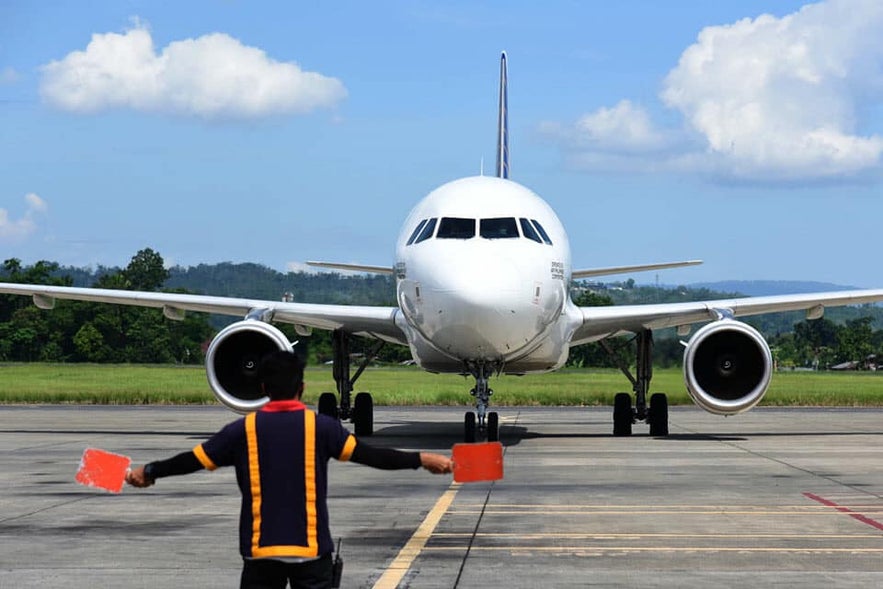
Photo by City Government of Davao
Despite its distance from the country’s political seats, Mindanao remains accessible thanks to the airports located in the busiest cities in this part of the country, making Mindanao tourist spots easily reachable. Davao is home to the largest flight hub in Mindanao. The Bancasi Airport (Butuan) and Zamboanga City International Airport are two Mindanao airports that receive a constant flow of passengers because of their geographical locations.
Francisco Bangoy International Airport (Davao Airport)
Davao Airport Codes: IATA: DVO, ICAO: RPMD
This Mindanao airport is also known as Davao International Airport. It serves not only Davao City but the rest of the Davao Region. Francisco Bangoy is the busiest airport on Mindanao Island and is connected to Davao City via the Carlos P. Garcia National Highway.
- Find flights to Davao
- Secure your Davao hotel booking
- Book Davao City tours
Airlines at Davao Airport
Francisco Bangoy International Airport serves both local and international airline companies.
Its international destinations include Manado, Indonesia via Garuda Airlines, Doha via Qatar Airways, Quanzhou via Xiamenair, Kuala Lumpur via AirAsia, and Singapore via Cebu Pacific and SilkAir.
Domestic airlines operating at Francisco Bangoy include Cebgo, Cebu Pacific, PAL Express, Philippine Airlines, and AirAsia Philippines.
Davao Airport Terminal
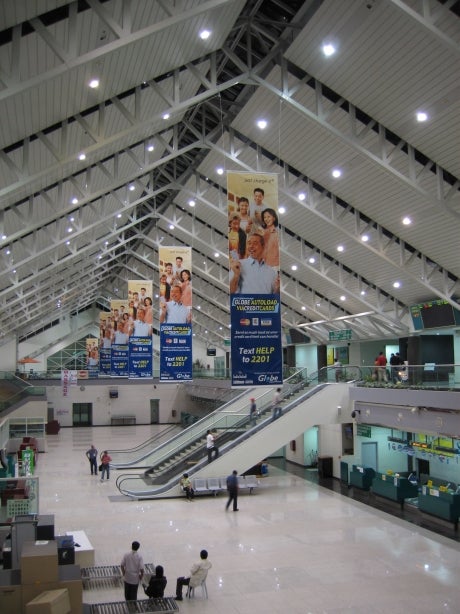
Photo by Davao International Airport
Francisco Bangoy International Airport has one massive passenger terminal that features a Malay architectural design. This terminal houses 14 international and 14 domestic check-in counters and four passenger jet bridges. In addition, it also has two arrival halls for domestic and international passengers. Aside from the passenger terminal, Francisco Bangoy also has a dedicated cargo terminal.
Destinations accessible from Davao Airport
Davao Airport gives passengers access to notable Davao tourist spots. These attractions include Mt. Apo (the tallest mountain in the Philippines), Samal Island, and the Philippine Eagle Center. Davao City, which is the third most prominent city in the Philippines, is only about 36 km away from Francisco Bangoy Airport.
From the airport, you can connect to top tourist destinations like the widely popular surfing town of Siargao, the Chocolate Hills in Bohol, and the Cagayan de Oro River in Cagayan de Oro. There are also regular flights going to Manila and Cebu. You can also get on a plane from here to Bacolod, the gateway to attractions like The Ruins, Campuestuhan Highlands, and Mt. Kanlaon National Park.
New Flight Routes in the Philippines (2025–2026)
The Philippines continues to rise as a major international travel hub in Southeast Asia, with more airlines launching direct routes to key gateways like Manila City and Cebu Island. These new connections mean shorter travel times, more competitive fares, and easier access to the country’s world-class islands, cities, and cultural destinations.
As of December 10, 2025, these are the new international routes now in operation:
New International Connections
-
Jetstar: Perth (Australia) → Manila City— Launching November 27
-
Jetstar: Brisbane (Australia) → Cebu Island — Starting December 3
-
Vietnam Airlines: Hanoi (Vietnam) → Cebu Island — Beginning December 2
-
VietJet: Ho Chi Minh City / Saigon (Vietnam) → Cebu Island — Launching November 22
-
AirAsia: Cebu → Kuala Lumpur & Cebu Island→ Macau — Starting November 15
-
Philippine Airlines: Cebu Island→ Guam — Launching December 16
-
Philippine Airlines: Manila City → Palau - Launching March 29, 2026
These new routes strengthen the Philippines’ role as a regional aviation gateway while giving travelers more flexible and affordable ways to reach top destinations across Luzon, Visayas, and Mindanao.
Expanded Domestic Connections
Regional airports in the Philippines are taking center stage, making domestic travel faster, easier, and more convenient. With Clark Airport and Cebu Airport emerging as key hubs, travelers can now reach more destinations across Luzon, Visayas, and Mindanao with greater flexibility.
-
Clark International Airport (CRK): As of October 26, 2025, CRK now serves twice-daily flights to destinations like Busuanga town (gateway to Coron town) and Basco town (Batanes Province).
-
Cebu Airport: Handles increased flights, including a new route to Calbayog City (Samar Province) via Philippine Airlines (PAL)
-
Cebu as a domestic hub: From mid-November 2025, expect revived routes such as Cebu–Davao, Cebu–Caticlan (gateway to Boracay Island), and Cebu–Iloilo, significantly improving access across the Visayas and Mindanao regions.
With these expanded connections, planning your next island adventure or city escape is now even easier—giving you more time to enjoy the Philippines’ stunning beaches, rich culture, and vibrant cities without the travel stress.
Other International Airports in the Philippines

Photo by Subic Bay International Airport
The Philippines has several operational international airports that serve commercial flights. This article has already discussed NAIA, Clark, Mactan-Cebu, Iloilo, and Francisco Bangoy Airport. The others are in this Philippine airport list:
Laoag International Airport
Airport Codes: IATA: LAO, ICAO: RPLI)
Area of Service: General area of Laoag, Ilocos Norte
Subic Bay International Airport
Airport Codes: IATA: SFS, ICAO: RPLB)
Area of Service: Metro Manila and Pampanga. Serves as a secondary and diversion airport
Puerto Princesa International Airport
Airport Codes: IATA: PPS, ICAO: RPVP)
Area/s of Service: general area of Puerto Princesa, Palawan
Kalibo International Airport
Airport Codes: IATA: KLO, ICAO: RPVK)
Area/s of Service: general area of Kalibo and Boracay Island of Aklan
Bohol–Panglao International Airport (also known as New Bohol International Airport)
Airport Codes: IATA: TAG, ICAO: RPSP)
Area/s of Service: general area of Tagbilaran and Panglao Island, Bohol
Bicol International Airport
Airport Codes: IATA: DRP, ICAO: RPLK
Area of Service: Legazpi, Albay, and the general area of the Bicol Region
General Santos International Airport (also called Tambler Airport)
Airport Codes: IATA: GES, ICAO: RPMR
Area of Service: General Santos City and Soccsksargen ( South Cotabato, Cotabato, Sultan Kudarat, Sarangani and General Santos). or Region XII
Zamboanga International Airport
Airport Codes: IATA: ZAM, ICAO: RPMZ)
Area of Service: Zamboanga City
There are three other airports in the Philippines that are classified as international airports. However, these airports currently serve international charter flights or seasonal flights and not full international commercial flights. They are:
Bacolod–Silay Airport (Bacolod-Silay International Airport)
Airport Codes IATA: BCD, ICAO: RPVB
Area of Service: Metro Bacolod, Western Visayas
Serves only seasonal international flights
Cagayan North International Airport (Lal-lo International Airport)
Airport Codes IATA: LLC, ICAO: RPLH
Area of Service: Cagayan Special Economic Zone
Serves international charter flights to and from Macau via Royal Air
Laguindingan International Airport (Cagayan de Oro Laguindingan International Airport)
Airport Codes IATA: CGY, ICAO: RPMY
Area of Service: Cagayan de Oro, Iligan and Marawi, and most of Northern Mindanao
Domestic Airports in the Philippines
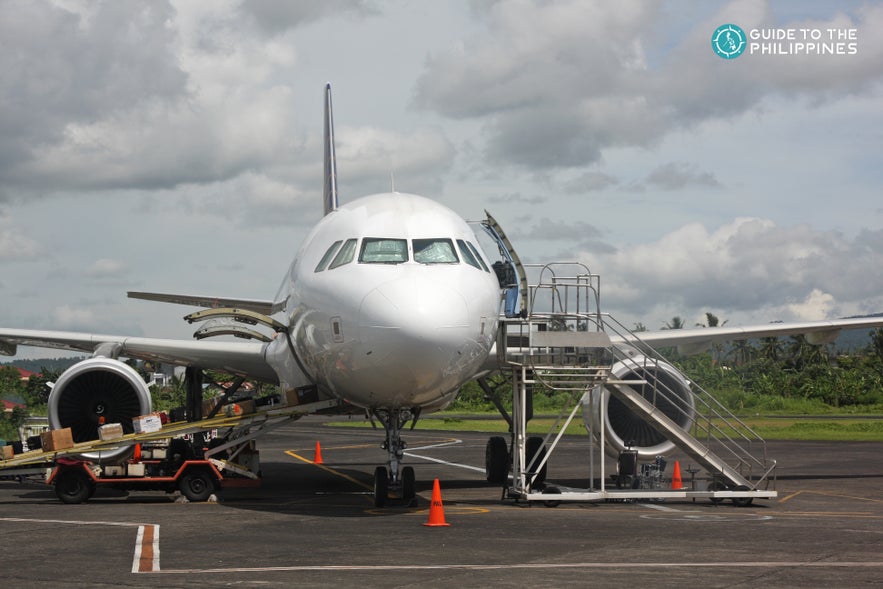
Here are the principal domestic airports in the Philippines:
Bancasi Airport
Airport Codes: IATA: BXU, ICAO: RPME
Area of Service: Butuan, Agusan del Norte
Cotabato Airport
Airport Codes: IATA: CBO, ICAO: RPMC
Area of Service: Datu Odin Sinsuat, Maguindanao
Daniel Z. Romualdez Airport (Tacloban City Airport)
Airport Codes: IATA: TAC, ICAO: RPVA
Area of Service: Tacloban, Leyte
Dipolog Airport
Airport Codes: IATA: DPL, ICAO: RPMG
Area of Service: Dipolog, Zamboanga Del Norte
Dumaguete–Sibulan Airport
Airport Codes: IATA: DGT, ICAO: RPVD
Area of Service: Sibulan
Naga Airport
Airport Codes: IATA: WNP, ICAO: RPUN
Area of Service: Pili, Camarines Sur
Pagadian Airport
Airport Codes: IATA: PAG, ICAO: RPMP
Area of Service: Pagadian, Zamboanga del Sur
Roxas Airport
Airport Codes: IATA: RXS, ICAO: RPVR
Area of Service: Roxas, Capiz
San Jose Airport
Airport Codes: IATA: SJI, ICAO: RPUH
Area of Service: San Jose, Occidental Mindoro
Tuguegarao Airport
Airport Codes: IATA: TUG, ICAO: RPUT
Area of Service: Tuguegarao City, Cagayan
Evelio Javier Airport (Antique/San Jose Airport)
Airport Codes: IATA: EUQ, ICAO: RPVS
Area of Service: San Jose de Buenavista, Antique
Basco Airport
Airport Codes: IATA: BSO, ICAO: RPUO
Area of Service: Basco (Batan Island), Batanes
Calbayog Airport
Airport Codes: IATA: CYP, ICAO: RPVC
Area of Service: Calbayog, Samar
Camiguin Airport
Airport Codes: IATA: CGM, ICAO: RPMH
Area of Service: Mambajao, Camiguin
Catarman National Airport
Airport Codes: IATA: CRM, ICAO: RPVF
Area of Service: Catarman, Southern Samar
Cuyo Airport
Airport Codes: IATA: CYU, ICAO: RPLO
Area of Service: Magsaysay (Cuyo Island), Palawan
Francisco B. Reyes Airport (Busuanga Airport)
Airport Codes: IATA: USU, ICAO: RPVV
Area of Service: Coron (Busuanga Island), Palawan
Godofredo P. Ramos Airport (Caticlan Boracay Airport)
Airport Codes: IATA: MPH, ICAO: RPVE
Area of Service: Malay/Nabas, Aklan
Jolo Airport
Airport Codes: IATA: JOL, ICAO: RPMJ
Area of Service: Jolo, Sulu
Airport Codes: IATA: BAG, ICAO: RPUB
Area of Service: Baguio, Benguet
Marinduque Airport
Airport Codes: IATA: MRQ, ICAO: RPUW
Area of Service: Gasan, Marinduque
Moises R. Espinosa Airport
Airport Codes: IATA: MBT, ICAO: RPVJ
Area of Service: Masbate, Masbate
Ormoc Airport
Airport Codes: IATA: OMC, ICAO: RPVO
Area of Service: Ormoc, Leyte
Sanga-Sanga Airport (Tawi-Tawi Airport)
Airport Codes: IATA: TWT, ICAO: RPMN
Area of Service: Bongao, Tawi-Tawi
Sayak Airport (Siargao Airport)
Airport Codes: IATA: IAO, ICAO: RPNS
Area of Service: Del Carmen (Surigao Island), Siargao, Surigao del Norte
CAAP Surigao Airport
Airport Codes: IATA: SUG, ICAO: RPMS
Area of Service: Surigao City, Surigao del Norte
Tandag Airport
Airport Codes: IATA: TDG, ICAO: RPMV
Area of Service: Tandag, Surigao del Sur
Tugdan Airport
Airport Codes: IATA: TBH, ICAO: RPVU
Area of Service: Alcantara (Tablas Island), Romblon
Virac Airport
Airport Codes: IATA: VRC, ICAO: RPUV
Area of Service: Virac
Tips for hassle-free travel
Before you book flights to and in the Philippines, make sure you can meet the Philippine airport requirements., Apart from securing the Philippines travel requirements, you must also be aware of and follow Philippine airport rules.
Airport baggage rules in the Philippines
The Philippine airport baggage rules depend on the airline you are flying with and the ticket you have booked. In general, you are allowed one cabin baggage that weighs a maximum of 7 kg. Double-check with your airline before your flight to avoid paying additional fees at the airport.
What to pay in Philippine airports
All travelers transiting via Philippine airports must pay a Philippine airport tax, more commonly known as a terminal fee. The amount depends on the airport you are transiting from. This is usually included in your airfare, and you don’t need to pay for it at the airport.
Travelers also need to pay a travel tax when leaving the Philippines. Non-immigrant foreigners who have stayed in the country for less than a year are exempted from paying this. The travel tax varies depending on your ticket class. You can pay for this online or at the airport.
What not to bring to Philippine airports
Philippine airport prohibited items vary from airport to airport, but in general, firearms, stunning devices, toxic substances, and explosives are not allowed.
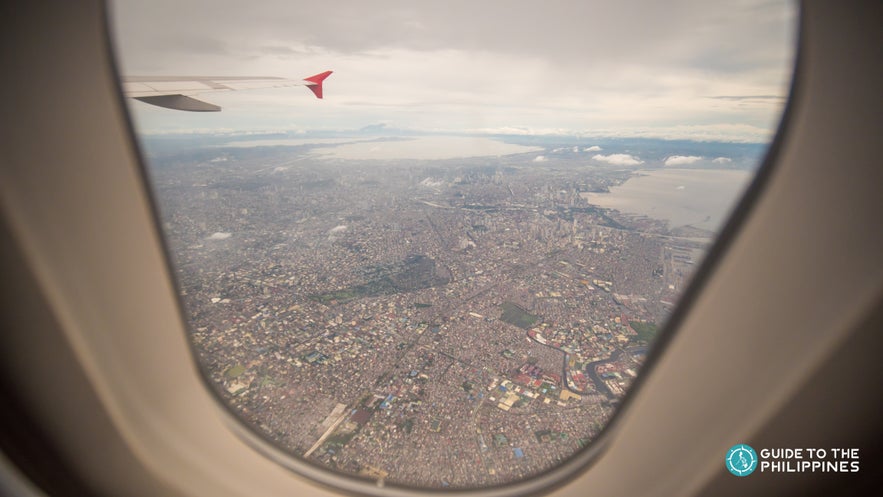
When exploring the Philippines, you will most likely fly more compared to other countries. After all, flying is the fastest and most convenient way to get around a country with thousands of islands. The good news is domestic airlines keep flight prices relatively affordable to accommodate millions of Filipinos flying every year.
Make sure to plan ahead and learn enough about the Philippine airports and the terminals you’re landing in. This small act of proactiveness will save you a lot of stress and headaches in the long run.












